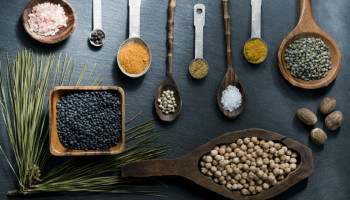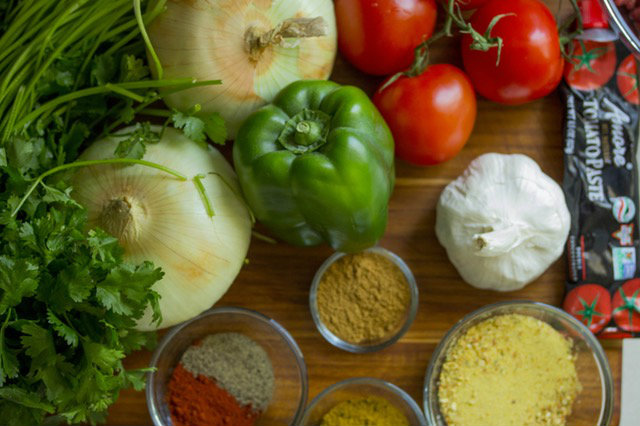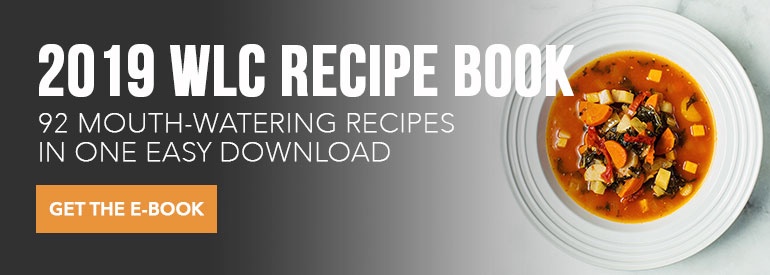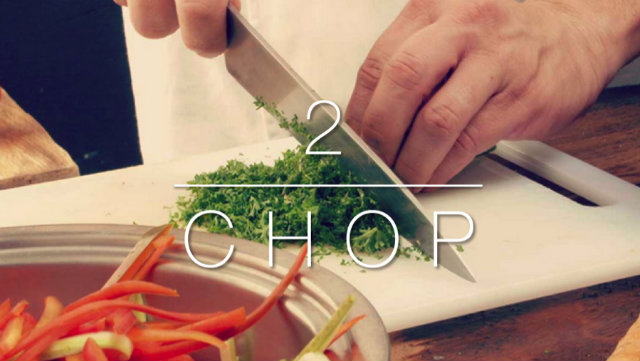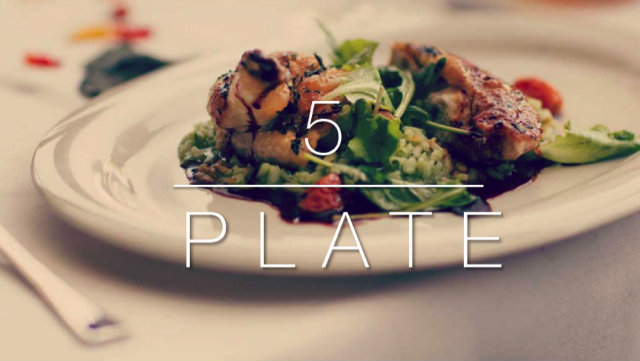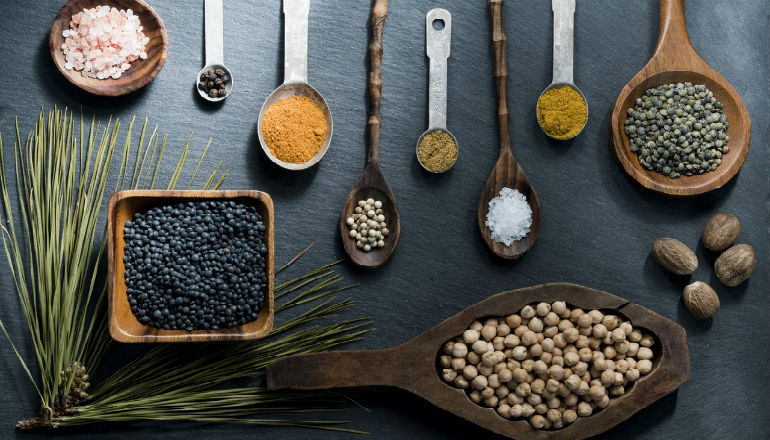 Reading Time: 7 minutes
Reading Time: 7 minutesBefore developing Kitchen Karate, I learned to cook by throwing dinner parties. Each week I invited six guests to be my guinea pigs as I tried my hand at a new cuisine: Chinese, Mexican, Italian, Indian, Thai, French, Caribbean, and many more.
I pulled recipes off the Internet for the most popular appetizer, entree and dessert from the cuisine of the week. I then spent five or more hours following the recipes to the letter as I shopped for and cooked the dishes. I billed myself as “America’s Top Recipe Follower,” and I had a lot of happy customers.
I noticed two things throughout the course of this culinary adventure. First, following recipes is beyond time consuming. Second, every cuisine in the world shares five seasonings. Can you guess what they are?
- Salt
- Pepper
- Olive oil (or the fat of your choice)
- Onion
- Garlic
I named these “The Starting 5” because they are the foundation of flavor. If you’ve been cooking along with the previous lessons of this home cooking boot camp, you are already familiar with the power of The Starting 5. But if not, you can still grasp their power with a simple thought experiment.
Think of any vegetable. Now imagine adding salt, pepper, olive oil, onion, and garlic and cooking it up. It’s going to taste pretty good, right? Now imagine any meat or meat substitute and do the same thing. The Starting 5 will make any whole fresh ingredient taste savory.
So why not just season everything with The Starting 5 and be done with it? To answer that, let’s take a closer look at our seasoning ingredients and how certain combinations of them result in something known as “flavor profiles.”
Variety Is the Real Spice of Life
On average we eat three meals a day. That’s 21 meals a week, and 1,092 meals a year. If you seasoned everything with The Starting 5 you would get bored — fast! This is why every culture has developed its own signature spin on seasoning. Thanks to merchant trading and a few spice wars, we have a world of flavors at our disposal.
Seasoning your way around the world is easy when you grasp the concept of flavor profiles. Every cuisine has unique cooking techniques and equipment, but for the most part, they all accomplish the same thing: getting you through The 5 Moves of cooking.
It’s the flavor profile of a cuisine that truly sets it apart. You can cook fajita fillings in a wok, but you can’t make it taste Chinese unless you swap the flavor profile.
Imagine you start with chicken, peppers and tomatoes. You divide them equally into two meals, meal A and meal B. You season both meals with The Starting 5 — salt, pepper, olive oil, onion, and garlic. Then, to meal A, you add jalapeno, lime, and cumin. To meal B, you add ginger, rice vinegar, and sesame seeds. Stir-fry both, and you are going to have two tasty, but distinctly different meals.
I have done a lot of study in the flavor profile department, and I believe there are at least ten truly distinct cuisines in the world. With ten distinct flavor profiles at your disposal, you can eat the exact same ingredients ten times and never feel you had the same thing twice. Add to this the fact that every time you change the ingredient mix, you create a new meal, and the possibilities for your meals become endless.
So, for this lesson’s drill, we are going to try our hand at the three most popular flavor profiles in America. Can you guess what they are?
Skill Drill: Utilizing the Power of Flavor Profiles
I suggest you use the exact same vegetable and meat ingredients for each of your three dishes so you can truly experience the power of flavor profiles.
Ingredients:
- 3 servings of a firm vegetable — carrots, cauliflower, broccoli, etc.
- 3 servings of a soft vegetable — tomato, mushrooms, peppers, etc.
- 3 servings of a meat or meat substitute
Note: for guidance on what constitutes a “serving size,” see lesson one.
Starting 5:
- Salt
- Pepper
- Fat of choice — olive oil, butter, coconut oil, ghee, etc.
- Onion
- Garlic
Mexican Flavor Profile:
- 1 thing sour — lime, lemon, apple cider vinegar
- 1 thing spicy — cayenne, chipotle, jalapeno
- 1 thing savory — oregano, cumin
- 1 thing clever — avocado, diced tomato, cilantro
Chinese Flavor Profile:
- 1 thing sour — rice vinegar, lime, lemon
- 1 thing spicy — ginger, white pepper, chili flakes
- 1 thing savory — Chinese five spice mix, sesame oil, peanut oil
- 1 thing clever — peanuts, sesame seeds, cilantro, coconut aminos, soy sauce substitute
Italian Flavor Profile:
- 1 thing sour — balsamic vinegar
- 1 thing spicy — red pepper
- 1 thing savory — oregano, basil, thyme, rosemary
- 1 thing clever — fennel seeds, diced tomato
I suggest you chop and distribute the ingredients uniformly between your three sets of meal containers. Do your work in this order:
- Chop your produce
- Chop and/or mince seasonings
- Change cutting boards
- Chop your meat and/or meat substitutes
Directions:
- Set your oven to 400 degrees.
- Ideally, you have three sets of identical ingredients chopped in the same way. The only difference in your three meals will be what you do here in the sprinkle move.
- Hit all three meals with as much or as little of The Starting 5 as you like. You can keep it uniform across all three meals, or vary it from one meal to the next as you see fit. You will experience the power of flavor profiles either way.
- Designate one meal as Mexican, one meal as Chinese, and one meal as Italian.
- For each meal, look at the appropriate flavor profile as outlined in the “shop” instructions above and add one thing from each of the four seasoning categories.
In total, you should have nine items to cook for your three meals. You can combine ingredients for the same meals to cook together as in a stir-fry, but don’t combine the same ingredients from different meals to cook together. For instance, don’t take your Mexican bell peppers and dump them in with your Chinese bell peppers to cook them together. That will ruin the point of the experiment.
Note: For a refresher on how to cook multiple meals at once, read lesson four. And for tips on how to gauge “doneness,” read lesson one.
Once your meals have cooled enough to eat, do a quick taste test of all three. Can you taste the difference in cuisines? Are you starting to experience the power of flavor profiles? Imagine how simple shopping can become if your spice cabinet is robust.
Pick our favorite of the three meals to eat right now, and pack the other two to enjoy later! And don’t forget to post to the comments below to tell us what you used and how it went.
Ready for more? Dive into the rest of the lessons in this series:
- The 5 Moves to Cooking Everything: Home Cooking Boot Camp Lesson 1
- Knife Skills and Stir Fry: Home Cooking Boot Camp Lesson 2
- The 3 Essential Cooking Methods: Home Cooking Boot Camp Lesson 3
- How to Make Multiple Meals at Once: Home Cooking Boot Camp Lesson 4
- How to Organize Your Kitchen for Speed: Home Cooking Boot Camp Lesson 5
- The Secret Tool of Taste Balancing: Home Cooking Boot Camp Lesson 7
- Learn to Play the 3 Flavor Notes: Home Cooking Boot Camp Lesson 8
